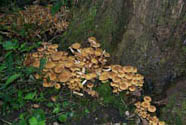 Key to Gilled Mushrooms Key
Key to Gilled Mushrooms KeyThis is a key to gilled mushrooms, that is, mushrooms having a definite cap with a fertile surface consisting of gills. The fruiting body usually also has a stem, although that may be lateral or absent (usually, then, the mushroom is growing from wood). You can use this key to identify mushrooms that you find.
 Agaricales Order
Agaricales OrderFruiting body containing fibers (usually in the stalk)
 White Spored Suborder
White Spored SuborderSpore print "light-colored": white or buff, sometimes tinged with pink or tan. Greenish and (except for the Russulales) yellow spore prints also go here
Stalk fibrous, not fracturing like a piece of chalk
 Tricholomataceae Family
Tricholomataceae FamilyNone of the special features distinguishing the other white-spored genera:
Gills not free, as in the Lepiotas and Amanitas
Basidia not extra-long, as in the Hygrophoraceae
Spores smooth, except for Lentinellus
 Lignicolous Trich Subfamily
Lignicolous Trich SubfamilyGrowing on trees or dead wood, leaves, or sticks, or organic debris, often in moss
 Normal LignoTrich Tribe
Normal LignoTrich TribeShaped like a “normal mushroom”
Small and fragile to medium-sized, except for one large, grey-capped species
Small Ligno Trich SubtribeFruiting body small: cap up to 1 1/4" across (and most clearly smaller than that)
Rickenella Genus

Diagnosis
- Very small, orangish, growing in moss
-
Spores inamyloid
-
Special cystidia
Narrow down your identification:
 Rickenella fibula
Rickenella fibulaCap up to 5/8" across; hemispherical and radially flat at first, becoming omphaloid and striate; pastel orange to buff
Stalk concolorous with cap, hollow, fragile
Gills white to buff (not as in picture)
Growing in moss






 Key to Gilled Mushrooms Key
Key to Gilled Mushrooms Key Agaricales Order
Agaricales Order White Spored Suborder
White Spored Suborder Tricholomataceae Family
Tricholomataceae Family Lignicolous Trich Subfamily
Lignicolous Trich Subfamily Normal LignoTrich Tribe
Normal LignoTrich Tribe
 Rickenella fibula
Rickenella fibula




